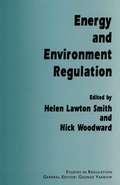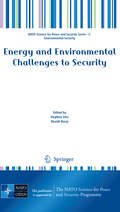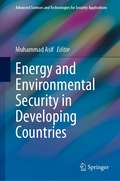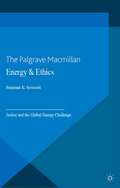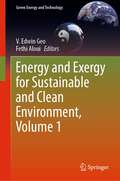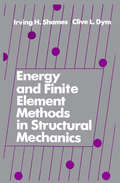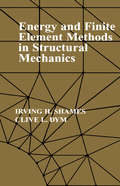- Table View
- List View
Energy and Environment Regulation (Studies in Regulation)
by Helen Lawton Smith Nick WoodwardThe central theme of this book is the relationship between the regulation of energy production and environmental regulation. The book explores four themes: Assessing Regulatory Impacts; Energy Pricing; Public Policy towards New Investment and Multi-Regulation, and includes contributions from leading analysts in the fields of economics, law, politics, business and technology policy.
Energy and Environmental Challenges to Security (NATO Science for Peace and Security Series C: Environmental Security)
by Stephen Stec Besnik BarajOn 21 November 2007 the grand and elegant Delegates Hall of the Hungarian Parliament was the scene of the opening of a conference to discuss some of the most pressing issues of the day, those related to our unending thirst for energy, its environmental consequences, and the challenges that these bear on security. Over the next 3 days scientists, parliamentarians and their guests confronted, challenged, teased and cajoled each other in a NATO Advanced Research Workshop (ARW) entitled “Energy and Environmental Challenges to Security,” affirming that knowledge and public service hold the keys to solving our greatest challenges. The magnitude of the security challenge was confirmed while this volume was being prepared. In mid-2008, the International Energy Agency issued a report concluding that US$45 trillion would be needed over the next half century to prevent energy shortages and greenhouse gas emissions from undermining global economic growth. But lest such large numbers cause us all to shrug, this volume brings attention to some of the more manageable aspects of the environment and energy security challenge – from addressing conflict resources such as illegal timber that contribute to corruption and regional instability, to means and mechanisms to enable the diversification of energy supplies, to environmental risk reduction strategies for particular installations. The participants in the Hungarian Parliament building were atypical for a NATO Advanced Research Workshop.
Energy and Environmental Engineering: Proceedings of the 2014 International Conference on Energy and Environmental Engineering (ICEEE 2014), September 21-22, 2014, Hong Kong
by Yijin WuThe 2014 International Conference on Energy and Environmental Engineering (ICEEE 2014) was held September 21-22, 2014 in Hong Kong. This proceedings volume assembles papers from various professionals, leading researchers, engineers, scientists and students and presents innovative ideas and research results focused on Energy and Environmental Engine
Energy and Environmental Outlook for South Asia
by Muhammad AsifSouth Asia constitutes a key geography in the world today considering its large population and related daunting energy and environmental challenges. Many countries in the region are faced with a growing gap between energy demand and local resources, resulting in an increased dependence on imports. According to the International Energy Agency (IEA), the energy demand in South Asia will grow at a rate more than double that of the world average in the coming decades. This book addresses the critical subject of energy and environmental outlook for South Asia and presents the wider challenges and the responses at the national and regional level. Features: Discusses and addresses the ongoing energy and environmental challenges faced by almost a quarter of the global population Includes dedicated chapters for each country and presents analysis and recommendations by regional experts Examines how deteriorating air quality and persistent natural disasters are severe environmental challenges for the region Discusses the implications of global warming and climate change for South Asia Includes practical case studies throughout Energy and Environmental Outlook for South Asia will benefit a wide range of stakeholders from various fields including but not limited to energy, environment, economics, national security, and sustainable development. It also serves as a valuable resource for academics, researchers, analysts, policymakers, and representatives of utilities, industry, professional bodies, financial institutions, think tanks, and developmental organizations to better plan their initiatives, activities, and policies. It will help countries in the region and also those around the world by learning from shared experience, and ideally by collaborating for energy and environmental prosperity.
Energy and Environmental Outlook for South Asia
by Asif MuhammadSouth Asia constitutes a key geography in the world today considering its large population and related daunting energy and environmental challenges. Many countries in the region are faced with a growing gap between energy demand and local resources, resulting in an increased dependence on imports. According to the International Energy Agency (IEA), the energy demand in South Asia will grow at a rate more than double that of the world average in the coming decades. This book addresses the critical subject of energy and environmental outlook for South Asia and presents the wider challenges and the responses at the national and regional level. Features: Discusses and addresses the ongoing energy and environmental challenges faced by almost a quarter of the global population Includes dedicated chapters for each country and presents analysis and recommendations by regional experts Examines how deteriorating air quality and persistent natural disasters are severe environmental challenges for the region Discusses the implications of global warming and climate change for South Asia Includes practical case studies throughout Energy and Environmental Outlook for South Asia will benefit a wide range of stakeholders from various fields including but not limited to energy, environment, economics, national security, and sustainable development. It also serves as a valuable resource for academics, researchers, analysts, policymakers, and representatives of utilities, industry, professional bodies, financial institutions, think tanks, and developmental organizations to better plan their initiatives, activities, and policies. It will help countries in the region and also those around the world by learning from shared experience, and ideally by collaborating for energy and environmental prosperity.
Energy and Environmental Policy Modeling (International Series in Operations Research & Management Science #18)
by John WeyantA Simple Model of Electric Power Network . . . . . . . . . . . . . . . . . . . . . . . . . . . . . . . . . . . . . . . . . . . . . . . 48 Power flow equations . . . . . . . . . . . . . . . . . . . . . . . . . . . . . . . . . . . . . . . . . . . . . . . . . . . . . . . . . . . . . . . . . . . . . . . . . . 48 Social welfare action . . . . . . . . . . . . . . . . . . . . . . . . . . . . . . . . . . . . . . . . . . . . . . . . . . . . . . . . . . . . . . . . . . . . . . . . . . . 49 A Market Mechanism . . . . . . . . . . . . . . . . . . . . . . . . . . . . . . . . . . . . . . . . . . . . . . . . . . . . . . . . . . . . . . . . . . . . . . . . . . . . . . . . 50 An efficient trading rule . . . . . . . . . . . . . . . . . . . . . . . . . . . . . . . . . . . . . . . . . . . . . . . . . . . . . . . . . . . . . . . . . . . . . . 51 Competitive equilibrium and social optimum . . . . . . . . . . . . . . . . . . . . . . . . . . . . . . . . . . . . . . . 52 A Dynamic Trading Process . . . . . . . . . . . . . . . . . . . . . . . . . . . . . . . . . . . . . . . . . . . . . . . . . . . . . . . . . . . . . . . . . . . . . . . 54 An Illustrative Example . . . . . . . . . . . . . . . . . . . . . . . . . . . . . . . . . . . . . . . . . . . . . . . . . . . . . . . . . . . . . . . . . . . . . . . . . . . . . 56 Alternative Implementation Plans . . . . . . . . . . . . . . . . . . . . . . . . . . . . . . . . . . . . . . . . . . . . . . . . . . . . . . . . 59 Conclusions . . . . . . . . . . . . . . . . . . . . . . . . . . . . . . . . . . . . . . . . . . . . . . . . . . . . . . . . . . . . . . . . . . . . . . . . . . . . . . . . . . . . . . . . . . . . . . . 59 Appendix . . . . . . . . . . . . . . . . . . . . . . . . . . . . . . . . . . . . . . . . . . . . . . . . . . . . . . . . . . . . . . . . . . . . . . . . . . . . . . . . . . . . . . . . . . . . . . . . . . . 60 References . . . . . . . . . . . . . . . . . . . . . . . . . . . . . . . . . . . . . . . . . . . . . . . . . . . . . . . . . . . . . . . . . . . . . . . . . . . . . . . . . . . . . . . . . . . . . . . . . 64 Endnotes . . . . . . . . . . . . . . . . . . . . . . . . . . . . . . . . . . . . . . . . . . . . . . . . . . . . . . . . . . . . . . . . . . . . . . . . . . . . . . . . . . . . . . . . . . . . . . . . . . . . 64 Chapter 5: The Berlin Mandate: The Design ofCost-Effictive Mitigation Strategies . . . . . . . . . . . . . . . . . . . . . . . . . . . . . . . . . . . . . . . . . . . . . . . . . . . . . . . . . . . . . . . . . . . . . 67 Introduction . . . . . . . . . . . . . . . . . . . . . . . . . . . . . . . . . . . . . . . . . . . . . . . . . . . . . . . . . . . . . . . . . . . . . . . . . . . . . . . . . . . . . . . . . . . . . . . 68 The Models . . . . . . . . . . . . . . . . . . . . . . . . . . . . . . . . . . . . . . . . . . . . . . . . . . . . . . . . . . . . . . . . . . . . . . . . . . . . . . . . . . . . . . . . . . . . . . . . 69 Future Emissions . . . . . . . . . . . . . . . . . . . . . . . . . . . . . . . . . . . . . . . . . . . . . . . . . . . . . . . . . . . . . . . . . . . . . . . . . . . . . . . . . . . . . . . 70 The Costs of Alternative Commitments . . . . . . . . . . . . . . . . . . . . . . . . . . . . . . . . . . . . . . . . . . . . . . . . . . . . . . 73 Some Final Comments . . . . . . . . . . . . . . . . . . . . . . . . . . . . . . . . . . . . . . . . . . . . . . . . . . . . . . . . . . . . . . . . . . . . . . . . . . . . . . . 80 Endnotes . . . . . . . . . . . . . . . . . . . . . . . . . . . . . . . . . . . . . . . . . . . . . . . . . . . . . . . . . . . . . . . . . . . . . . . . . . . . . . . . . . . . . . . . . . . . . . . . . . . . 82 Chapter 6: Some Implications of Improved CO] Emissions Control Technology in The Context of Global Climate Change . . . . . . . . . . . . . . . . . . . . 85 Introduction . . . . . . . . . . . . . . . . . . . . . . . . . . . . . . . . . . . . . . . . . . . . . . . . . . . . . . . . . . . . . . . . . . . . . . . . . . . . . . . . . . . . . . . . . . . . . . . 85 The CET A-R Model . . . . . . . . . . . . . . . . . . . . . . . . . .
Energy and Environmental Security in Developing Countries (Advanced Sciences and Technologies for Security Applications)
by Muhammad AsifThis book presents a comprehensive account of the energy and environmental security perspectives of the developing countries. To address the subject comprehensively, it covers four geographically diverse clusters of developing countries from across the world. The regions particularly focused on are: South Asia, South East Asia, Sub Sahara Africa, and Latin America. It is a valuable contribution to the debate, and policy and research activities around the subjects of energy and environmental security in the developing countries and beyond.The book covers the interwoven subjects of energy security and environmental security in the context of developing countries for the first time. It discusses the latest dimensions, challenges, and solutions around taking into account technical, economic, social, and policy perspectives. It incorporates up-to-date data, case studies, and comparative assessment.This edited book has contributions from established as well as emerging scholars from around the world. It benefits a wide range of stakeholders from the fields of energy, environment, and sustainable development. It is of help to academics, researchers, and analysts in these fields besides having appeal for policymakers, and national and international developmental organizations. It also helps developing countries to learn from each other’s experiences.
Energy and Environmental Strategies in the Era of Globalization (Green Energy and Technology)
by Muhammad Shahbaz Daniel BalsalobreThis book provides readers with cutting-edge techniques that can be applied to energy and environmental economics. Further, it highlights the effects that both globalization and economic growth have on the environment. In addition to offering a broader perspective on the relationship between environmental pollution, energy consumption and economic growth, the book studies the relationship between economic growth and environmental damage by drawing on the theoretical hypothesis of the Environmental Kuznets Curve. The book presents new econometric techniques and innovative approaches to the study of the energy economy. Accordingly, it can be used to help analyse the current state of the energy economy, the environment and globalization, and can serve as a theoretical reference manual for doctoral students and academics seeking new analytical techniques.
Energy and Ethics: Justice and the Global Energy Challenge (Energy, Climate and the Environment)
by Benjamin K. SovacoolBenjamin K. Sovacool applies concepts from justice and ethics theory to contemporary energy problems, and illustrates particular solutions to those problems with examples and case studies from around the world.
Energy and Evolutionary Conflict: The Metabolic Roots of Cooperation
by Neil W. BlackstoneIn the mid- to late-twentieth century, large scientific conflicts flared in two seemingly distinct fields of scientific inquiry. In bioenergetics, which examines how organisms obtain and utilize energy, the chemiosmotic hypothesis of Mitchell suggested a novel mechanism for energy conversion. In evolutionary biology, meanwhile, Wynne Edwards strongly articulated the view that organisms may act for the “good of the group.” This work crystalized a long history of imprecise thinking about the evolution of cooperation. While both controversies have received ample attention, no one has ever suggested that one might inform the other, i.e., that energy metabolism in general and chemiosmosis in particular might be relevant to the evolution of cooperation. The central idea is nevertheless remarkably simple. Chemiosmosis rapidly converts energy, and once storage capacity is exceeded, an overabundance of product has various negative consequences. While to some extent chemiosmotic processes can be modulated, under certain circumstances it is also possible to simply disperse the products into the environment.This book argues that these two heretofore distinct scientific disciplines are connected, thereby suggesting that a ubiquitous process of energy conversion may underlie the evolution of cooperation and link major transitions in the history of life that have been regarded as mechanistically unrelated.
Energy and Exergy for Sustainable and Clean Environment, Volume 1 (Green Energy and Technology)
by V. Edwin Geo Fethi AlouiThis multi-disciplinary book presents the most recent advances in exergy, energy, and environmental issues. Volume 1 focuses on fundamentals in the field and covers current problems, future needs, and prospects in the area of energy and environment from researchers worldwide. Based on some selected lectures from the Eleventh International Exergy, Energy and Environmental Symposium (IEEES-11) and complemented by further invited contributions, this comprehensive set of contributions promote the exchange of new ideas and techniques in energy conversion and conservation in order to exchange best practices in "energetic efficiency." Included are fundamental and historical coverage of the green transportation and sustainable mobility sectors, especially regarding the development of sustainable technologies for thermal comforts and green transportation vehicles. Furthermore, contributions on renewable and sustainable energy sources, strategies for energy production, and the carbon-free society constitute an important part of this book.
Energy and Finance: Sustainability in the Energy Industry
by André Dorsman Özgür Arslan-Ayaydin Mehmet Baha KaranThis book analyses how socially responsible investments as well as the rising importance of Islamic finance are linked to the shift towards renewable energy. Academics and practitioners in the field take a global perspective and present case studies from several countries. The book is divided into three parts: The first part sheds new light on the energy shift towards renewable energy. The second shows the increasing interest of investors in sustainability, and the authors argue that investors not only look at expected returns and risks, but also at social returns. Finally, the third part explains the need for social returns in Islamic finance, which cannot be explained by traditional finance theory. This is the fifth volume in a series on energy organized by the Centre for Energy and Value Issues (CEVI).
Energy and Finite Element Methods in Structural Mechanics
by IrvingH ShamesTHE FINITE ELEMENT METHOD : Basic Concepts and ApplicationsDarrell Pepper, Advanced Projects Research, Inc. California, and Dr . JuanHeinrich, University of Arizona, TucsonTh i s introductory textbook is designed for use in undergraduate, graduate, andshort courses in structural engineering and courses devoted specifically to thefinite element method. This method is rapidly becoming the most widely usedstandard for numerical approximation for partial differential equations definingengineering and scientific problems.The authors present a simplified approach to introducing the method and a coherentand easily digestible explanation of detailed mathematical derivations andtheory Example problems are included and can be worked out manually Anaccompanying floppy disk compiling computer codes is included and required forsome of the multi-dimensional homework problems.
Energy and Finite Element Methods In Structural Mechanics: SI Units
by IrvingH ShamesFirst published in 1996. CRC Press is an imprint of Taylor & Francis.
Energy and Finite Element Methods In Structural Mechanics: SI Units
by IrvingH ShamesFirst published in 1996. CRC Press is an imprint of Taylor & Francis.
Energy and Fuel Systems Integration (Green Chemistry And Chemical Engineering Ser.)
by Yatish T. ShahEnergy and Fuel Systems Integration explains how growing energy and fuel demands, paired with the need for environmental preservation, require different sources of energy and fuel to cooperate and integrate with each other rather than simply compete. Providing numerous examples of energy and fuel systems integration success stories, this book:Discu
Energy and Fuel Systems Integration (Green Chemistry And Chemical Engineering Ser.)
by Yatish T. ShahEnergy and Fuel Systems Integration explains how growing energy and fuel demands, paired with the need for environmental preservation, require different sources of energy and fuel to cooperate and integrate with each other rather than simply compete. Providing numerous examples of energy and fuel systems integration success stories, this book:Discu
Energy and Household Expenditure Patterns (Routledge Revivals)
by Thomas J. Lareau Joel DarmstadterOriginally published in 1983, Energy and Household Expenditure Patterns claimed that two-thirds of energy consumption in the United States came from households. This study aimed to estimate the expected changes in household activities and how this would affect energy consumption in the country as a whole. Also discussed are implications of direct energy purchases and spending on energy goods in households as well as predicting the growth in energy consumption leading up to the year 2000. This title will be of interest to students of Environmental Studies and Economics.
Energy and Household Expenditure Patterns (Routledge Revivals)
by Thomas J. Lareau Joel DarmstadterOriginally published in 1983, Energy and Household Expenditure Patterns claimed that two-thirds of energy consumption in the United States came from households. This study aimed to estimate the expected changes in household activities and how this would affect energy consumption in the country as a whole. Also discussed are implications of direct energy purchases and spending on energy goods in households as well as predicting the growth in energy consumption leading up to the year 2000. This title will be of interest to students of Environmental Studies and Economics.
Energy and Mass Transfers: Balance Sheet Approach and Basic Concepts
by Abdelhanine BenallouThis is the first book of a series aiming at setting the basics for energy engineering. This book presents the fundamentals of heat and mass transfer with a step-by-step approach, based on material and energy balances. While the topic of heat and mass transfer is an old subject, the way the book introduces the concepts, linking them strongly to the real world and to the present concerns, is particular. The scope of the different developments keeps in mind a practical energy engineering view.
Energy and Mass Transfers: Balance Sheet Approach and Basic Concepts
by Abdelhanine BenallouThis is the first book of a series aiming at setting the basics for energy engineering. This book presents the fundamentals of heat and mass transfer with a step-by-step approach, based on material and energy balances. While the topic of heat and mass transfer is an old subject, the way the book introduces the concepts, linking them strongly to the real world and to the present concerns, is particular. The scope of the different developments keeps in mind a practical energy engineering view.
Energy and Matter Fluxes of a Spruce Forest Ecosystem (Ecological Studies #229)
by Thomas FokenThis book focuses on fluxes of energy, carbon dioxide and matter in and above a Central European spruce forest. The transition from a forest affected by acid rain into a heterogeneous forest occurred as a result of wind throw, bark beetles and climate change. Scientific results obtained over the last 20 years at the FLUXNET site DE-Bay (Waldstein-Weidenbrunnen) are shown together with methods developed at the site, including the application of footprint models for data-quality analysis, the coupling between the trunk space and the atmosphere, the importance of the Damköhler number for trace gas studies, and the turbulent conditions at a forest edge. In addition to the many experimental studies, the book also applies model studies such as higher-order closure models, Large-Eddy Simulations, and runoff models for the catchment and compares them with the experimental data. Moreover, by highlighting processes in the atmosphere it offers insights into the functioning of the ecosystem as a whole. It is of interest to ecologists, micrometeorologists and ecosystem modelers.
Energy and Process Optimization for the Process Industries
by Frank (Xin ZhuExploring methods and techniques to optimize processing energy efficiency in process plants, Energy and Process Optimization for the Process Industries provides a holistic approach that considers optimizing process conditions, changing process flowschemes, modifying equipment internals, and upgrading process technology that has already been used in a process plant with success. Field tested by numerous operating plants, the book describes technical solutions to reduce energy consumption leading to significant returns on capital and includes an 8-point Guidelines for Success. The book provides managers, chemical and mechanical engineers, and plant operators with methods and tools for continuous energy and process improvements.
Energy and Process Optimization for the Process Industries
by Frank (Xin ZhuExploring methods and techniques to optimize processing energy efficiency in process plants, Energy and Process Optimization for the Process Industries provides a holistic approach that considers optimizing process conditions, changing process flowschemes, modifying equipment internals, and upgrading process technology that has already been used in a process plant with success. Field tested by numerous operating plants, the book describes technical solutions to reduce energy consumption leading to significant returns on capital and includes an 8-point Guidelines for Success. The book provides managers, chemical and mechanical engineers, and plant operators with methods and tools for continuous energy and process improvements.
Energy and protein metabolism and nutrition in sustainable animal production (European Association for Animal Production #134)
by James W. Oltjen, Ermias Kebreab and Hélène LapierreAs world population increases, demand for food and particularly animal products is expected to grow substantially. Because of limited area for expansion of animal agriculture and growing consumer concern for the environmental impact of animal production, gains in animal efficiency will have to be part of the solution. This book addresses key issues of how energy and protein are utilized and interact in farm animals from the molecular to the whole animal and even to the herd or group level of organization. It contains state-of-the-art research and reviews on several topics of nutrient utilization and metabolism from top scientists worldwide. Key issues addressed include energy/protein interactions, methodology such as in vitro and in vivo techniques, regulation including pre-natal programming and endocrine regulation, modeling and systems biology (including a tribute to the late Professor R. Lee Baldwin of the University of California, Davis, a leader in the field), products and health of animals, tissue metabolism, and environmental sustainability in agriculture. This book is a valuable resource for researchers, students, policy makers, producers and industry professionals believing that a better understanding of metabolism and nutrition of farm animals is part of the solution.
